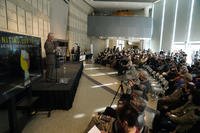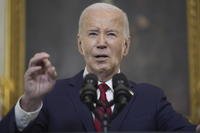The tanker competition did not change much publicly this morning after EADS NA received its briefing from the Air Force on just why Boeing won the $35 billion program.
“The EADS North America team has met with the Air Force, received a debriefing and is evaluating the information presented to us. Our objective has always been that the U.S. warfighter receive the most capable tanker, following a fair and transparent competition. That remains our position today,” said company spokesman Guy Hicks.
Put this together with comments made when the Boeing win was announced by EADS Chairman Ralph Crosby, saying in a statement that the Air Force had picked “a high-risk concept aircraft over the proven, more capable KC-45…” and you have a hungry company moving very cautiously. EADS NA has other major programs at stake and must be weighing every opportunity before it starts to publicly lean one way or another in deciding to file a bid protest. Crosby also made clear the company might not say much more for a while given the program’s complexity.
Richard Aboulafia, one of the aerospace world's best informed analysts, offered this summary of the competition in his monthly newsletter, which came out today:
"Fuel. This is the biggest issue, because it’s the biggest thing that’s changed over the past few years since the last KC-X contract. We’ve all known the terms of the competitive equation between the KC-30 and KC-767. The former plane ismore capable, but it costsmore to buy and burnsmore fuel.
The added capability stayed constant. The higher price tag was reduced with a very aggressive EADS bid. But fuel is the one thing EADS could do nothing about.
Let’s look at the numbers. According to the authoritative Airline Monitor (November 2010), the average 767-300ER inUS airline service burns about 1,550 gallons per block hour (Boeing’s tanker uses a smaller airframe, but more equipment, so we don’t know it’s exact burn rate). The average A330 in US airline service (-200s and -300s; the FAA doesn’t break them out, but the KC-30 too would carry more equipment) burns about 1,900 gallons per block hour. If fuel is $50/bbl, that fuel burn difference isn’t the end of theworld. If you star twith a base year assumption of $100/bbl, and then add the usual US Government fuel cost inflation factor for a 30 year life span, multiply it times
X hundreds of flight hours per year times 179 aircraft, you get a fuel-related operating cost difference wide enough to drive a truck through. The EADS up-front price discount would have been dwarfed by this huge fuel cost divergence."








